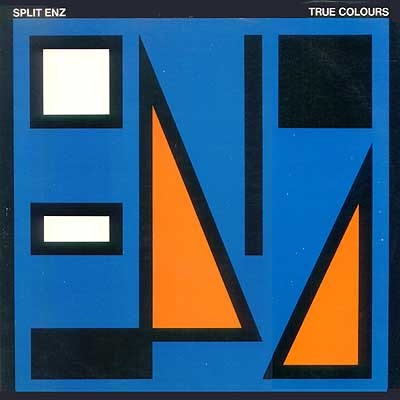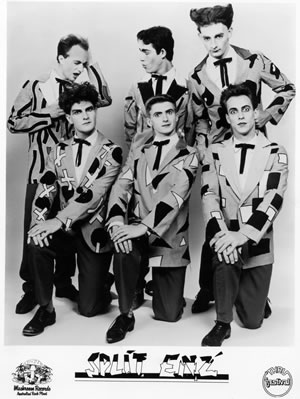
Cover of the album True colours
Cracking the big time
In 1980 Split Enz put New Zealand music firmly on the international scene with their album True colours. They were the first New Zealand act to break into the highly lucrative British and United States markets. This was not a case of overnight success. Split Enz had worked hard to get to the top, and like many New Zealand bands before them (and since), they had to overcome many obstacles to crack the big time.
Whether it is due to a sense of isolation or the small size of the country, international recognition has been important to many New Zealanders. People in New Zealand like to think of themselves as being able to punch above their weight – whether it is in sport, film, writing or music. The Split Enz story is a classic example of Kiwi battlers achieving international success through hard work and sacrifice.
Brothers Tim and Neil Finn are seen as the major forces behind Split Enz, and they have become something akin to New Zealand rock royalty. But the tall poppy syndrome has seen others criticise Split Enz for their commercial success – as if, somehow, this was a sign of selling out.

Split Enz in 1979
The band’s career had two distinct phases. Split Enz started out as an 'adventurous, flamboyant art-rock band', first performing in 1971 at the University of Auckland. The original line-up comprised Tim Finn, Mike Chunn, Robert Gillies and Phil Judd (Noel Crombie joined in 1974). In 1972 the band members went full-time and called themselves Split Ends. A move to Australia in 1975 saw the band become Split Enz, the ‘nz’ signifying its New Zealand roots.
This first incarnation of Split Enz lasted through the move to Australia and the early part of the band's stay in England in 1976. It ended when co-founder Phil Judd left in 1977. By that time the band had built a reputation as a unique and very visual live act, with colourful costumes (designed by Noel Crombie) and wild hair. They enjoyed moderate success with albums such as Mental notes (1975), Second thoughts (1976), Dizrythmia (1977) and Frenzy (1979) without really making the big time.
After the departure of Phil Judd, a new line-up consolidated behind Tim Finn, who was joined by his younger brother Neil.
Struggling to break through
In 1978 the band had no record deal and no booking agent or manager. Unable to get gigs, the band members were forced to go on the dole. A New Zealand Arts Council grant of $5000 offered a sliver of hope. The band used the money to book a small studio in Luton, England, and over five days it recorded what became known as the ‘Rootin' Tootin' Luton Tapes’. Included in these 28 demo recordings was a frenetic new song by Tim called ‘I see red’.
Later that year a number of the Luton songs made it onto their new album, Frenzy. The album art represented a departure from the flamboyant image of the past. Gone was the make-up and over-the-top costumes. Instead the band was painted in a relaxed pose in front of a New Zealand farm shed. ‘I see red’ failed to break into the British charts but did get good airtime and helped gain the band critical attention in England.
The band returned home to perform at the Nambassa music festival at Waihi in January 1979. It was a triumphant return. Although their gear had been destroyed in a fire and they had to play with borrowed instruments, they stunned the crowd with a stellar performance. The energy of their live show helped propel ‘I see red’ up the New Zealand charts, where it peaked at number 15. Although neither Frenzy nor its second single, ‘Give it a whirl’, made any impression on the charts, it was clear that the band had turned a corner.
True colours
But Split Enz was still struggling financially. It was this more than anything else that forced the band to reconsider its music and image. Their reception at Nambassa convinced them to pursue a more melodic ‘power-pop’ approach.
For their upcoming album, True colours, they concentrated on writing songs that had a commercial quality. The album highlighted the immense songwriting talent of the Finn brothers. Their styles were very different, with Tim described as being more 'melancholic' and Neil described as being the optimist with the upbeat sound. These different styles complemented each other perfectly to produce pop songs with an edge. The wild make-up and hairstyles were toned down, and Noel Crombie came up with a new look. His striking geometric patterns for new costumes, album art and stage designs ensured the band retained a unique image.
Music videos were increasingly becoming an important way of marketing performers and their music. The Finn brothers were seen as being very marketable. Mushroom Records recognised that they had teen appeal and pushed this in the videos made to support True colours.
End of the struggle
The band’s change in direction paid off. True colours was an international success. The single ‘I got you’, written and sung by Neil and featuring a chorus reminiscent of the Beatles, topped the charts in Australia, New Zealand and Canada. It peaked at number 12 in Britain and number 53 in the United States.
The album went to number one in New Zealand and Australia and made the Top 40 in Britain and the United States. The success of True colours also helped to push earlier albums (with the exception of Second thoughts) back into the New Zealand charts.
Split Enz built on their success with Waiata in 1981 (released as Corroboree in Australia), which topped the album charts on both sides of the Tasman and made the United States Top 50. The band then completed a hat-trick of number one albums in 1982 with Time and tide, which also topped the charts in Canada.
‘Six months in a leaky boat’ was the big hit from Time and tide. Voted the fifth-best New Zealand song ever in the 2001 Australasian Performing Right Association list, in many ways it reflected the band members’ sense of who and what they were. It summed up their own long journey while capturing the experiences of settlers who made the arduous voyage from Europe in the 19th century. Like Dave Dobbyn’s ‘Loyal’, the song became an unofficial anthem for New Zealanders making the return journey as part of their overseas travel in the late 20th century.
When I was a young boy
I wanted to sail around the world
That's the life for me, living on the sea
Spirit of a sailor, circumnavigates the globe
The lust of a pioneer, will acknowledge
No frontier
I remember you by, thunderclap in the sky
Lightning flash, tempers flare,
'round the horn if you dare
I just spent six months in a leaky boat
Lucky just to keep afloatAotearoa, rugged individual
Glisten like a pearl
At the bottom of the world
The tyranny of distance
Didn't stop the cavalier
So why should it stop me
I'll conquer and stay free
Ah c'mon all you lads
Let's forget and forgive
There's a world to explore
Tales to tell back on shore
I just spent six months in a leaky boat
Six months in a leaky boatShip-wrecked love can be cruel
Don't be fooled by her kind
There's a wind in my sails
Will protect and prevail
I just spent six months in a leaky boat
Nothing to it leaky boat.
See the video of 'Six months in a leaky boat' on YouTube.com.
Bad timing?
‘Six months in a leaky boat’ became caught up in controversy when it was released in Britain during the Falklands War. Some in Britain believed it was a veiled criticism of the war with Argentina. Despite being recorded in January 1982, before the Falklands dispute began, it was removed from radio play lists in the United Kingdom. British naval casualties during the conflict perhaps made any reference to leaking boats too sensitive an issue.
End of an era
By 1983 the band was running out of steam. Tim Finn was looking for new challenges as a solo artist. After the moderately successful albums Conflicting emotions (1983) and the appropriately titled See ya 'round (1984), the band called it quits.
Many New Zealand bands have had to pursue their careers in Australia, where the bigger market improved their chances of making a living from music. Split Enz was no different. Despite their success in the early 1980s, you won’t find this iconic home-grown band amongst the lists of annual New Zealand music award winners; as they recorded overseas, mainly in Australia, their records were ineligible. Being based in Australia for a good part of their existence also led the Australian public to claim them as one of their own – a fate shared by numerous other New Zealand acts that have made it in Australia.
Split Enz OnScreen
Split Enz videos from the NZ On Screen collection:
'Bold as brass', Dizrythmia, 1977
'I see red', Frenzy, 1979
'I got you', True colours, 1980
'History never repeats', Waiata, 1981
'Message to my girl', Conflicting emotions, 1983
See also Spellbound, a 1993 documentary about Split Enz narrated by Sam Neill.


Community contributions